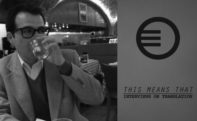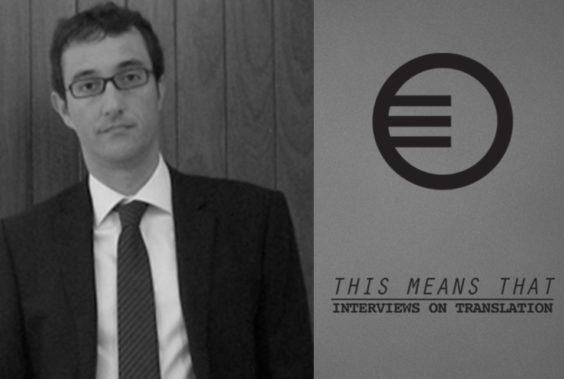
Por Interview by Brenda Lozano, Spanish to English Translation by Ana Isabel Martínez

Brenda Lozano: What book or story led you to English?
Miguel Temprano García: I wouldn’t be able to pinpoint a single book, but it was undoubtedly the books I read during my childhood and teenage years that awoke my interest in the English language. You know, Stevenson’s stories, Conan Doyle’s accounts, Joseph Conrad’s novels and so many others.
Tell us about your first translation.
My first translation was a gorgeous book by William Henry Hudson, Far Away and Long Ago. It’s a real gem, a book that radiates luminosity. Hudson wrote it when he was older and in it recounts his childhood in the Argentinian pampa with an almost mystic delicacy, his experiences among the gauchos and his interest in the fauna and flora of the region where he lived. It truly is something rather distant, given that I highly doubt anyone could have a childhood with such freedom as his nowadays.
Is translation a way to get closer or move away from the original text?
There lies one of the greatest paradoxes of translation. In order to pour the text into another language you have to get close to the original text to understand and unravel it; yet at the same time, translation implies a process of recreation that inevitably entails a certain distancing from the original.
How faithful are you to the original? How would you describe that fidelity, more literal, more conceptual?
I always aim to be as faithful as possible, but it’s very important to be careful and ensure the translation doesn’t come out too idiomatic. It’s a difficult balance. I would say I was more literal in the past. Now I’m more willing to betray literality to get the line to sound and breathe better.
Is there a metaphor, some lines or verses that depict your idea of translation?
It might sound a bit pedestrian, but in all honesty translation has become the same for me as hard liquor for drinkers or hard drugs for drug addicts. It’s like I can’t content myself with just reading.
Does translation exist only within the confines of language or are there other forms of translation whose materiality aren’t words?
There are several forms of translation that don’t use words (I’m thinking of music, film or photography), but they all use their own language. Without it there isn’t any thought and it’s not like there isn’t any translation, it’s that there’s nothing at all.
¿Qué libro o qué historia te llevó al Inglés?
No sabría decir un único libro, pero sin duda fueron los libros que leí en mi niñez y mi adolescencia los que despertaron mi interés por la lengua inglesa; qué sé yo, los cuentos de Stevenson, los relatos de Conan Doyle, las novelas de Joseph Conrad y otros muchos.
Háblanos de tu primera traducción.
Mi primera traducción fue de un libro precioso de William Henry Hudson, Allá lejos y tiempo atrás. Es una auténtica joya, un libro que irradia luminosidad. Hudson lo escribió ya mayor y en él rememora con una delicadeza casi mística su infancia en la pampa argentina, sus vivencias entre los gauchos y su interés por la fauna y la flora de la región donde vivía. Es, efectivamente, algo muy lejano porque dudo mucho que hoy nadie pueda tener una infancia tan libre como la suya.
¿Es la traducción una forma de acercarse o una forma de alejarse del texto original?
Ahí radica una de las mayores paradojas de la traducción, para verter el texto a otro idioma hay que acercarse al texto original para entenderlo y desentrañarlo, pero, al mismo tiempo, la traducción implica un proceso de recreación que, inevitablemente, implica un alejamiento del original.
¿Qué tan fiel eres al original? ¿Cómo caracterizarías esa fidelidad, ¿más literal, más conceptual?
Siempre procuro ser lo más fiel posible, pero es muy importante tener cuidado de que la traducción no resulte demasiado idiomática. Es un equilibrio difícil. En otras épocas diría que era más literal. Ahora estoy más dispuesto a traicionar la literalidad con tal de que la frase suene y respire mejor.
¿Hay alguna metáfora, algunas frases o versos que retraten tu idea de la traducción?
Tal vez suene un poco pedestre, pero lo cierto es que para mi la traducción se ha convertido en lo mismo que los licores fuertes para los bebedores o las drogas duras para los drogadictos. Es como si no me conformase sólo con leer.
¿La traducción sólo existe en los confines del lenguaje o hay otras formas de traducción cuyo material no sean las palabras?
Hay muchas formas de traducción que no utilizan palabras (pienso en la música, en el cine o en la fotografía), pero todas utilizan su propio lenguaje. Sin él no hay pensamiento y no es que no haya traducción, es que no hay nada.
Miguel Temprano García was born in Madrid. He is a biologist and an English teacher. Temprano García has worked as a United Nations translator and has translated authors such as Sherwood Anderson, A. S Byatt, Thomas Carlyle, John Cheever, G.K. Chesterton, J. M Coetzee, N. Gordimer, Joseph Conrad, Michael Cunningham, Daniel Defoe, Charles Dickens, Ford Madox Ford, E. Gaskell, George Gissing, Ernest Hemingway, H. P. Lovecraft, Herman Melville, George Orwell, Daniel Defoe, John Steinbeck, Robert Louis Stevenson and Francis Scott Fitzgerald.
Brenda Lozano was born in Mexico City. A narrator and essayist, she contributes to Letras Libres and Día Siete, among other publications. Her newest work, Cómo piensan las piedras, was released in 2017 from ALFAGUARA. She is the Spanish Language Editor for MAKE and Co-Director of the Lit & Luz Festival.
Jose Antonio Villarán was born in Lima, Perú. He is the author of el cerrajero (Album del Universo Bakterial, 2012). In 2008 he created the AMLT project, an exploration of hypertext literature and collective authorship; the project was sponsored by Puma from 2011-2014. His third book, titled open pit, is forthcoming from AUB (Lima). He is currently a PhD student of Literature at the University of California-Santa Cruz.
Miguel Temprano García nació en Madrid. Es biólogo y profesor de inglés. Ha sido traductor externo en Naciones Unidas y, además ha traducido a autores clásicos como Sherwood Anderson, A. S Byatt, Thomas Carlyle, John Cheever, G.K. Chesterton, J. M Coetzee, N. Gordimer, Joseph Conrad, Michael Cunningham, Daniel Defoe, Charles Dickens, Ford Madox Ford, E. Gaskell, George Gissing, Ernest Hemingway, H. P. Lovecraft, Herman Melville, George Orwell, Daniel Defoe, John Steinbeck, Robert Louis Stevenson and Francis Scott Fitzgerald.
Brenda Lozano nació en la ciudad de México. Es narradora and ensayista. Colabora con Letras Libres y Día Siete, entre otras publicaciones. Su libro, Cómo piensan las piedras, fue publicado en 2017 por ALFAGUARA. Es editora para MAKE Magazine y también es Co-Directora del Lit & Luz Festival.
José Antonio Villarán nació en Lima, Perú. Es el autor de el cerrajero (Album del Universo Bakterial, 2012). En 2008 creyó el proyecto AMLT, una exploración de literatura de hypertext y autoridad colectiva; el proyecto fue patrocinado por Puma de 2011-2014. Su tercer libro, open pit, viene por AUB (Lima). Villarán está matriculado en el programa de doctorado en Literatura de la Universidad de California-Santa Cruz.















click to see who
MAKE Magazine Publisher MAKE Literary Productions Managing Editor Chamandeep Bains Assistant Managing Editor and Web Editor Kenneth Guay Fiction Editor Kamilah Foreman Nonfiction Editor Jessica Anne Poetry Editor Joel Craig Intercambio Poetry Editor Daniel Borzutzky Intercambio Prose Editor Brenda Lozano Latin American Art Portfolio Editor Alejandro Almanza Pereda Reviews Editor Mark Molloy Portfolio Art Editor Sarah Kramer Creative Director Joshua Hauth, Hauthwares Webmaster Johnathan Crawford Proofreader/Copy Editor Sarah Kramer Associate Fiction Editors LC Fiore, Jim Kourlas, Kerstin Schaars Contributing Editors Kyle Beachy, Steffi Drewes, Katie Geha, Kathleen Rooney Social Media Coordinator Jennifer De Poorter
MAKE Literary Productions, NFP Co-directors, Sarah Dodson and Joel Craig